- Home
- Patient Stories
- Hip Dysplasia - Randale Lambert
College student credits hip surgery for changing his life and career path
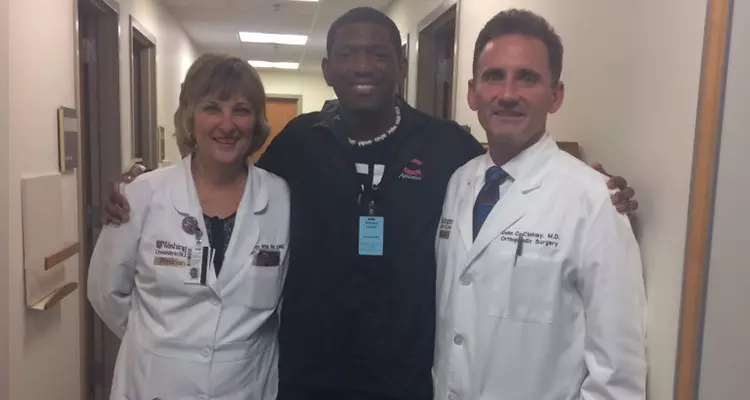
An unintended injury that lead to a cutting edge surgery ended up changing Randale Lambert’s life and career path.
Randale Lambert has always had a passion for running. In 2010, while on a partial scholarship at Iowa Wesleyan, he became injured during an afternoon game of “pick-up” football. He and some friends were just goofing around when a tackle ended with a left hip labral tear for Lambert. Lambert says he really didn’t think much of it when he felt a pop in his hip but once he got back to practice, he started experiencing pain while running which affected his performance in practice and made it impossible to compete for the rest of the season.
He transferred to the Kansas State University and tried to become a member of their track team in the spring of 2011, but the pain had become worse. After five months of rehabilitation with the Kansas State’s sports physical therapy team, the left hip pain had not improved. As a result, he was referred to John Clohisy, MD, a Washington University Orthopedic Reconstruction specialist with Barnes-Jewish Hospital and Barnes-Jewish Hospital West County, and Director of the Adolescent and Young Adult Hip Disorders Center. Upon further evaluation, Lambert was diagnosed with bilateral hip dysplasia (shallow hip sockets) and would need major surgery on both hips.
Hip dysplasia is a deformity of the hip joint that causes instability and or looseness of the joint making it more prone to injuries. Most commonly, hip dysplasia is characterized by a “shallow” socket that does not adequately cover the femoral head. When the femoral head is not completely covered by the acetabulum, the hip is unstable, may become painful and eventually develop osteoarthritis. The normal hip is a ball and socket joint with the femoral head (ball) well-seated and stable within the acetabulum (socket).
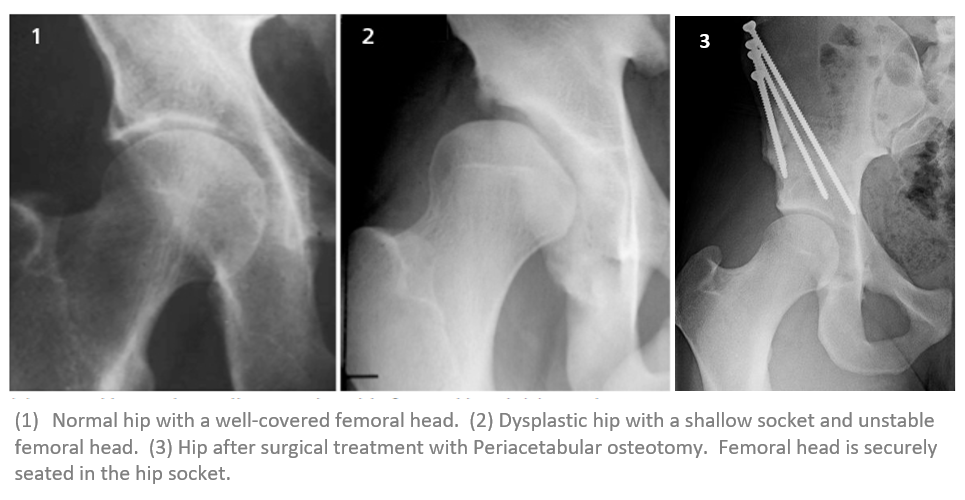
Dr. Clohisy has always had a genuine interest in the young collegiate athletes because he wants to get them back to their sports and their academic career as quickly as possible. Lambert had surgery on his left hip in July of 2011. He says that as he prepared for the surgery, he understood that approximately 80% of athletes are able to return to their sport post-op and there was a chance he may not return to running competitively. “It was a leap of faith but felt it was the right choice for me,” says Lambert.
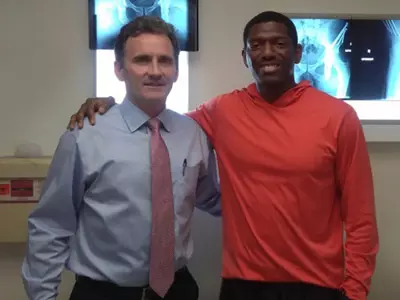
Photo: Randale and Dr. Clohisy
“I fully believe that God sent me to Dr. Clohisy, meeting him and his nurse Madelyn changed my life.” The surgery was only one aspect of Lambert’s life that changed. In addition, to finding out about his deformity and being treated by a surgeon whose expertise was treating his type of deformity and then meeting Dr. Clohisy’s nurse who would have a profound effect on his life. Madelyn Curry is a clinical nurse coordinator who works closely with Dr. Clohisy and his patients.
Curry has been Dr. Clohisy’s clinical nurse and first assist in the operating room for over 16 years. One of the main components of her job is perioperative management, meaning she handles everything from the preoperative patient evaluation to getting a patient signed up and scheduled for surgery, rounding on the patient after surgery and monitoring the patient’s recovery. Curry says, “I am very involved with the patients. I pride myself on knowing every patients name and getting to know them personally.” Hip dysplasia can often affect both hips and require two separate hip surgeries. Curry explains, “I have seen most of our patients come through the process twice so there is a lot of time spent over several years with our patients.”
Even so, a special bond was formed between Curry and Lambert. She says, “I was very impressed by the level of determination and independence that Randale had at such a young age. You just knew he was going to succeed. He would finish college and get back to running competitively. I don’t think that most understand the complexity of this surgery and how challenging full recovery can be but Randale didn’t seemed phased by it.” Lambert was told by Dr. Clohisy that it could take six months to one year before he would compete at a high level. Most patients are released without restrictions at four months after surgery but take additional time to return to previous activities.
Lambert made a full recovery from his first surgery that repaired his labral tear and repositioned the hip socket to correct the hip dysplasia in his left hip. He says, “I really had to listen to my body. My pool workouts helped me recover. I got back to running. It was during this time that I realized that I may not want to continue going to school to be a physical therapist. I started looking at other options. I reached out to Curry for her advice.” Curry says, “I would randomly hear from Randale throughout the years and we’d talk about school and various career possibilities.”
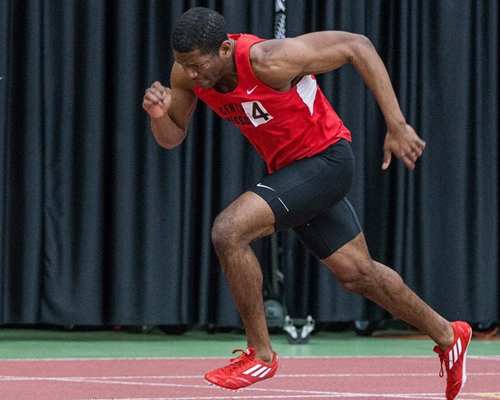
Photo: Randale competing at University of Central Missouri; taken by Andrew Mather
By 2013 Lambert was attending the University of Central Missouri and back to running track. In 2015, four years after his first hip surgery, Lambert had his second hip preservation surgery. “My recovery from the second surgery was a lot easier. I knew what to expect. I knew how my body would respond,” says Lambert.
Six months post-surgery, Lambert was back to training and by the ten month mark, he was competing at a high level. Lambert says, “I was on a post collegiate track team. My running times since have actually improved but that first competition, my times were right in line with my best running times ever.” He also gives credit for his fast recovery to the resources he had available to him at the University of Central Missouri, “I had a great coaching staff, the rehab facility with the athletic trainers, a pool, weight room facility and an indoor and outdoor track.”
All the while, Lambert stayed in touch with Curry. With her guidance, he looked into nursing school and found out that all of his physical therapy credits would transfer. Lambert decided on attending the Goldfarb School of Nursing and graduated in August of 2018. He was awarded the Ruth G Franc Kindness Award and Curry was there to watch him graduate. The Ruth G Franc Kindness Award is presented Fall, Spring and Summer Term to a graduate of the Bachelor of Science in Nursing Accelerated or Upper Division Program who has demonstrated exemplary caring and kindness to patients and their families.
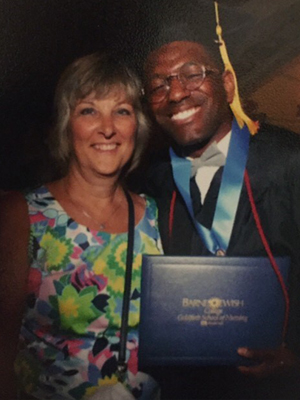 Photo: Randale with Curry at his graduation from Goldfarb School of Nursing at Barnes-Jewish College
Photo: Randale with Curry at his graduation from Goldfarb School of Nursing at Barnes-Jewish College
Lambert credits Curry with the change in his career path, “I watched Madelyn and the other nurses and how they put me at ease and made me feel comfortable and it made me want to give back what I received.” Lambert recently was given the opportunity to give back. He traveled to Peru, South America for a mission trip with fellow nursing students, instructors/nursing professionals from Goldfarb School of Nursing, and nurses from Barnes-Jewish Hospital. While in Peru, Lambert says, “the nurses instilled hope to the people by providing medications, food and nursing care for major and minor injuries.” This recent experience combined with his nursing education and own journey as a patient have further strengthened Lambert’s commitment to his future nursing career.
More Info: